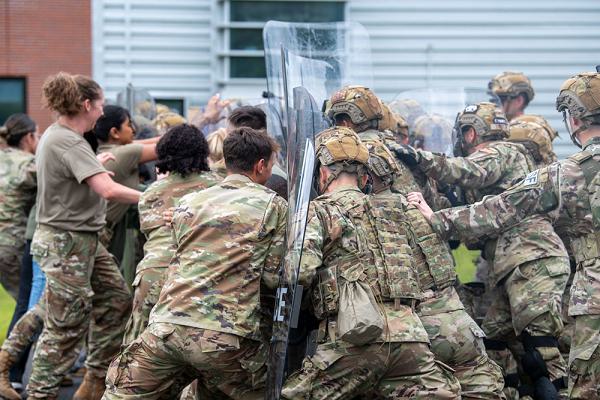
Westfield, Massachusetts. (August 31, 2024): In America, everyone has the right to demonstrate, march, and protest and such activities are protected under the First Amendment to the U.S. Constitution. In this photo by Jay Hewitt, members of the 104th Fighter Wing Security Forces Squadron conduct riot control training with civilians volunteering to function as an unruly crowd. The event offered riot control teams invaluable training in crowd control and tactical strategies.
While legitimate protests are an essential right, there are times when these types of gatherings get out of control and law enforcement is forced to step in. Websters describes a civil disturbance as “an unlawful assembly that constitutes a breach of the peace or an assembly of individuals that creates a threat of property damage, violence, or other unlawful acts.” Responding to these disturbances requires understanding proper crowd control tactics that protect life and property without unduly restricting a citizen’s right to protest.
When training for riot control, there are some essential skills and techniques that security officers should learn. The first task is to have a concise plan in place on how to deal with crowd control before things get out of hand. Officers should have clearly defined roles in managing unrest and they need to understand under what circumstances they can use force or make arrests.
Second, officers require the proper equipment such as riot suits to defend against a wide range of trauma as well as helmets, gloves, shields, and batons. Officers should use their gear for crowd “management” rather than control and the use of force, detentions, and arrests should be avoided during peaceful demonstrations whenever possible.
To keep groups at ease, officers should clearly communicate the thresholds for arrests and issue warnings when participants are nearing violating the law. Law enforcement should have a tailored response based on the moods and actions of crowds and to be aware of words or actions that can potentially increase tensions and escalate the situation. This is done using different formations that serve specific functions such as separating rioters from peaceful protesters. Once the officers gain control over a crowd, the last step is to deescalate the situation to prevent further damage or injuries.
While every American has a constitutional right to demonstrate, military police must be prepared to effectively respond to chaotic situations while protecting life and property.


